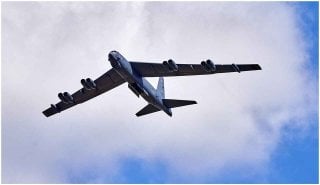Retire the B-52? Heck No: It's Getting Another Upgrade
The B-52 has been in service since the 1950s—and remarkably, the Air Force has no plans of retiring the old bomber.
The B-52 Stratofortress is one of the oldest machines in service anywhere within the US military. But the mid-19th-century bomber will be getting a modernizing update in the form of brand new Rolls Royce F130 engines. Altitude testing for the new engines is set to begin in February.
“The F130 engines, which will be a key part of the bombers’ transformation into the B-52J, are now on track to start altitude testing at the Air Force’s Arnold Engineering Development Complex in Tennessee in February,” Defense News reported. “During altitude testing, the engines will be evaluated at various simulated altitudes to see how well they perform in different flight conditions.”
Updating a Classic
The B-52 has been in service since the 1950s—and remarkably, the Air Force has no plans of retiring the old bomber. But the current B-52 fleet is in need of some attention; many of the parts and systems are old, prone to breaking, and requiring extra maintenance. The existing engines, the 60-year-old TF33s, are a particular point of concern for they find “new and creative ways of breaking,” as one Air Force officer stated. And maintaining the TF33 is becoming increasingly difficult as spare parts become harder to find, forcing maintainers to cannibalize other TF33 engines to find the parts needed for a repair, which is obviously an unsustainable arrangement.
The F130 upgrade is expended to extend the B-52’s service life through the 2050s or 2060s, which would push the B-52 past the one-century-in-service mark. To put that in perspective, the B-52 began flying when aviation itself was barely fifty years old, so if the B-52 were to hit one hundred years, the bomber would have been in service for two-thirds of the entire time aviation existed.
The B-52 won’t be the first jet to use the F130 engine; the F130 is already in service with the Gulfstream G650 business jet. However, the B-52 uses a novel twin pod underwing configuration that requires a different mount than the one currently in use with the G650. The Air Force needs to test the twin pod mounting system before signing off on the new engine. So far the tests have been going well.
“Tests to make sure the engines will work in their twin pod configuration, which were held at NASA’s Stennis Space Center, took place this summer,” Defense News reported. “Those rapid twin pos tests also helped show Rolls-Royce’s predictions on how the engines would operate were accurate, the company said, which reduced the amount of risk the program faces.”
Sea-level testing of the F-130 has also been completed. Now, tests at various altitudes will commence, and if successful, lead to the formal installation of the F130 as the B-52J’s engine.
If all goes as planned, the F130-equipped B-52Js will join the B-21 Raider as the two bombers in service with the Air Force; both the B-1 and B-2 are slated for retirement—ironic given that both debuted decades after the B-52.
Harrison Kass is a senior defense and national security writer with over 1,000 total pieces on issues involving global affairs. An attorney, pilot, guitarist, and minor pro hockey player, Harrison joined the US Air Force as a Pilot Trainee but was medically discharged. Harrison holds a BA from Lake Forest College, a JD from the University of Oregon, and an MA from New York University. Harrison listens to Dokken.
Image: Wikimedia Commons.

